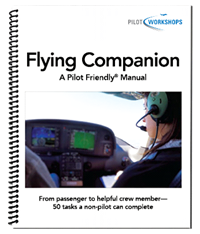The Companion Copilot video series provides frequent companion passengers—who are not pilots—an opportunity to learn more about how they can pinch hit and help their pilot and enjoy being an active participant in the flight.
The series covers preflight tasks, simple aerodynamics concepts, navigation and communication considerations, checklist use, and emergency procedures. Non-pilot passengers will learn how they can help with the preflight, route planning, navigation, and radio communications, including how to work with ATC.
They’ll come away with a greater understanding of how airplanes fly and be better prepared to enjoy the flight, knowing they can be of help using fundamental concepts reviewed in the videos.
Note, the video series is intended to give viewers an overview of basic flying concepts. To learn more, see the resources below and talk to your pilot or a certificated flight instructor.
Preflight
AOPA Foundation donor Libby Maus introduces viewers to the video series aimed at providing frequent companion passengers a positive flight experience as participating passengers. Learn about flight planning, route and weather considerations, go/no-go decisions, and the role you as a non-pilot can play in making it a safe and enjoyable flight.
Aviate
This video explains basic aerodynamic concepts, how the flight controls work, and that the airplane can glide to a safe landing if an engine were to quit. Get a broad overview of glass and conventional avionics, including how to use and monitor those systems.
Navigate
Review aeronautical charts used for flight route planning and navigation, including a discussion of GPS functions, how to locate airports, pinpointing the destination, and using ATC to obtain taxi instructions.
Communicate
Learn about communication radio functions, how to tune and activate frequencies, and transponder use. Also, get tips on how to speak on the radio and how to work with ATC.
Emergency
This video explains what to do in case of an emergency, such as an engine or other system failure. Emergency discusses how to pinch hit and help your pilot using the emergency checklist, ATC, and the knowledge you’ve gained from the previous videos.
Additional Resources:
- Pilots and companion copilots can review ASI’s Critical Information: The Passenger Safety Briefing video. It covers often-overlooked items that should be part of every preflight passenger briefing.
- Download and print out the Passenger Safety Briefing Card to indicate emergency equipment locations and operation. Keep the briefing card in a handy location in the cockpit.
- Want to learn more about manipulating the flight controls? Review the Companion Copilot Syllabus, which is designed to help non-pilot flying companions learn more about flying an airplane.
- Interested in taking the next step? Take a look at Are You Ready To Take Off? and find what it takes to learn to fly for fun or for a career.

